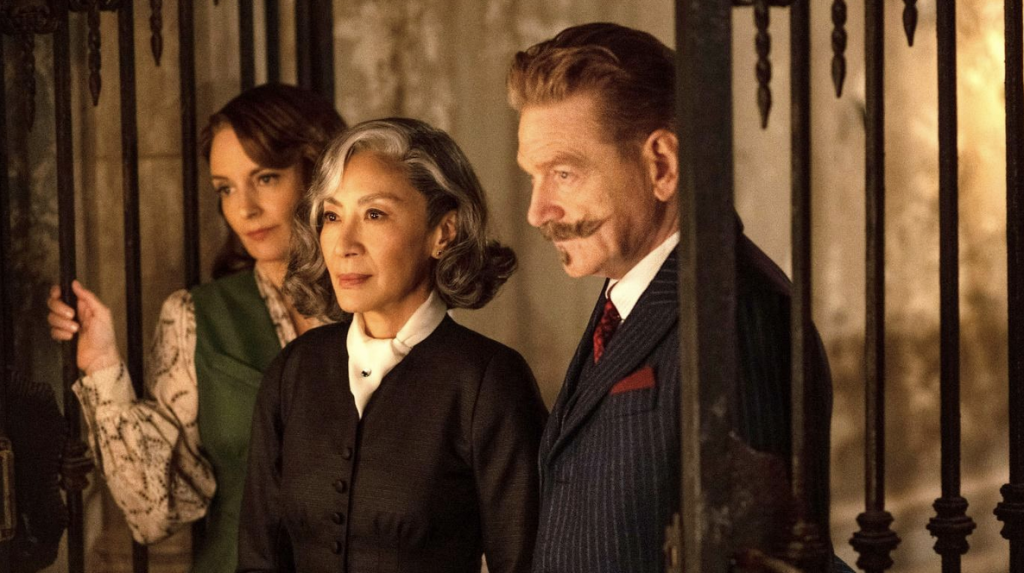By Arjan Arenas
3.5/5 stars
Kenneth Branagh is back (as is that ridiculous moustache) for a third time as Hercule Poirot. Following on from 2017’s so-so Murder on the Orient Express and last year’s Death on the Nile, which made it into cinemas after being beset by issues behind the camera, Agatha Christie’s legendary Belgian sleuth returns for another big-screen outing to make Branagh’s series of adaptations a trilogy now, with the actor once again also in the director’s chair (as well as being one of the producers, another being Ridley Scott).
As we edge towards Halloween, his hat-trick effort, A Haunting in Venice – based on one of Christie’s lesser-known novels, 1969’s Hallowe’en Party – tries to offer suitably spooky viewing. However, while the movie’s source material, like many of the Queen of Crime’s mysteries, is set in a quintessentially English country house, A Haunting in Venice transplants the backdrop to – wait for it – Venice. It’s an aesthetically strong choice; as night falls on one of Europe’s most beautiful cities, Branagh’s regular cinematographer Haris Zambarloukos expertly captures the dark blue skies and shadows of spires to evoke a subtly eerie atmosphere. This film definitely gets you in the mood for Halloween, if it doesn’t do much else.
Set in 1947, in the film’s opening scene, it’s just another day for Poirot, waddling along the cobbled streets of Venice, picking up his order of pastries, and evading crowds of people pestering him to solve the murders of their loved ones. Clearly, it’s tough being the world’s most famous detective. However, he’s now retired, and living comfortably in isolation, other than the company of his trusty Italian bodyguard (Riccardo Scamarcio). Not for long, though.
Poirot is summoned by his old friend, bestselling American mystery writer Ariadne Oliver (Tina Fey, playing it mostly straight for once), to accompany her to a Halloween party at the palazzo of a renowned opera singer (Kelly Reilly). “We Americans might be responsible for loud music and terrible chocolate,” Oliver wryly notes, “but we also brought back Halloween”. The star attraction is a séance to be conducted by famous medium Joyce Reynolds (Michelle Yeoh), whom Oliver wants to see Poirot – no great believer in the supernatural – expose as a fraud. The séance goes ahead, and Poirot duly utilises his powers of deduction to debunk Reynolds’ methods. Shortly afterwards, a shrouded figure tries to drown him, and seconds after that, a grisly murder occurs. After locking all the party guests – now the suspects – inside the palazzo, the world’s most famous detective swiftly gets back in business.
For its effectively macabre atmosphere – especially in a scene earlier on in the film when the children of a local orphanage are treated to a puppet retelling of an old horror story at the Halloween party – A Haunting in Venice is a much more restrained affair than the over-extravagantly camp previous two films. Whereas those movies put their star-studded ensemble casts front and centre, here, the emphasis, refreshingly, stays on Poirot himself, who’s not in his usual self-assured mood as he wearily comes out of retirement, and slowly eases himself back into solving murders.
Other than Branagh, Fey, and Yeoh, there are only two big names among the suspects, both of whom turn in great performances: Jamie Dornan as the opera singer’s family doctor, deeply disturbed by his wartime experiences and by a haunting past death for which he blames himself; and Camille Cottin as the singer’s devout Catholic housekeeper, seeming to play a much kindlier character than the actress’s usual devious, cynical roles. Special mention also goes to Jude Hill as the doctor’s precocious 12-year old (making this the second film in which he and Dornan have played father and son, after Branagh’s semi-autobiographical Belfast), who later proves crucial to unravelling the mystery.
In a testament to how scaled back this movie feels compared to its predecessors, Branagh’s own performance as Poirot – which is still very much in the shadow of the definitive interpretation of the character by David Suchet – is much quieter, compared to the actor’s usual scenery-chewing. Even his long-awaited delivery of that famous introduction to his hosts, “I am ‘air-cule Poirot”, feels much more subdued, and with a less thick Belgian accent. Yet it’s Fey – taking the place of Poirot’s sidekick Bouc (Tom Bateman) from the first two films – who provides the film’s standout performance in a rare serious role, albeit not without a mischievous twinkle in her eye. It helps that Michael Green’s script gives her most of the best lines, like this gem while she watches the puppet show: “Scary stories make real life feel less scary.”Unfortunately, for all its plus-points, the film is brought down by Branagh’s work on the other side of the camera. His direction feels too by-the-numbers, and lacks the emotional investment of the performances and cinematography. Additionally, Green (who also wrote the scripts for the first two movies) imbues this film with one too many flashbacks to highlight past events which are important to the main plot; in his hands, the old method of “Show, don’t tell”, becomes “Show a lot, then tell a bit, then show some more”. As well as this, the reveal of the perpetrator at the end felt a bit predictable (although I suppose it’s a bit harsh to blame Green for this as well, bearing in mind that this is an adaptation). Because of these shortcomings, A Haunting in Venice never really rises above being an hour-and-a-half’s entertaining Halloween viewing. However, taken as what it is, it’s ultimately a satisfying watch that might leave the hardcore Christie fan a bit cold, but will definitely get the average viewer in the mood for the spooky season.




